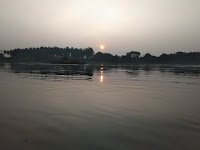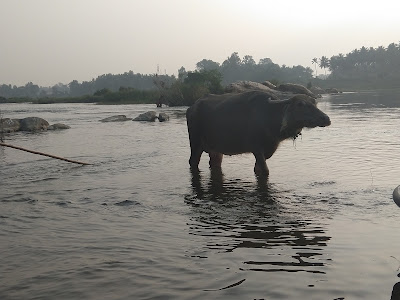I am in a coracle on the Cauvery River alongside
Siddu, a seasoned 58-year-old fisher, with an easy smile, boundless knowledge
and slow, careful, languorous gait. He
uses a long pole that has a rubber seal at the bottom end to push the coracle
upstream with a rhythm born of experience and skill. I cannot master this, not in this lifetime,
even if I wished to.
We stop at reedbeds by the side of the
banks searching for plastic and other
recyclable waste that can be hauled out:
soda-alcohol-and-water bottles, sacks, footwear, an occasional shirt or trouser,
broken plastic utensils. If there is
something he cannot recognise, it is left alone….is this a tenet of his earthy
philosophy, I wonder as I write this. I am keen to clean up to perfection, to remove all the waste I see, but he is wiser and I defer to his judgement.
 On this gorgeous Saturday wintry afternoon,
there are eight other fishers in four coracles doing the same thing in a river
stretch we call the Temple Corridor.
On this gorgeous Saturday wintry afternoon,
there are eight other fishers in four coracles doing the same thing in a river
stretch we call the Temple Corridor.
Corridor, because this river stretch has an active smooth-coated otter population. Temple, for there is a
beautiful shrine upstream, one that is about eight hundred years old, but has
never been prayed in – the reasons are etched in the bigoted stones of troubled
history – yet the river alongside is worthy of prayer, for it sustains life as nothing else can. In its now-truncated flow
traverses a complex culture, even as it continues to be the purveyor of fortune
and the receptacle for those rites of passage to a larger unknown realm.
So much for language.
We have just been informed by a passing
coracle that a romp of otters are on their way downstream and will cross us in
a while. My pulse throbs, of course, yet
for Siddu it is another day at work – he sees them everyday and they steal fish
off his nets, but he does not hold a grudge; they too need to survive, he says,
with that fetching smile I have now grown to like so much.
Two fishers in another coracle are moving
upstream in the middle of the river, dropping fishing nets and checking their
cage-traps – locally called ‘kodabe’ - for fish.
‘Can you see any otters?’ Siddu shouts out.
‘They are coming downstream, along your
bank.’ is the reply. My binoculars
aren’t with me, so, much as I try, I am unable to see anything.
 |
| Not just the Sun, others did some reflecting too |
We park the coracle and take our places on
a stretch of sand. A silent wait as I
stare at the river in placid, gentle flow two weeks after the monsoons bid adieu. It is easy to get distracted by reflection,
for isn’t that what the river’s surface does, the odd fish breaking through to
spring in its arc and enter with a ripple in its wake. Waiting for otters does that to me. Always.
Siddu sees the romp way before I do and
signals that they are going to be swimming close to us. Sure enough, we see them two minutes later,
seven heads bobbing up and down, chirping and squeaking away to each other,
ducking into the water and emerging a few feet downstream. They see us and call out to each other in
animated alarm, bobbing up and down in the water in that classic periscopic
pose. To us the message, rather the
question, is clear: just what are you two doing here?
Seconds later, they are in the middle of
the river, swimming away from us to an island close to the opposite bank. ‘I think they have a den there,’ Siddu says,
‘they use a number of dens at any one time.’
He is right, of course.
My day is made. I rarely carry a camera and prefer to watch
rather than shoot, for they are mutually exclusive tasks in every sense. Wildlife photographers, I must add, are patient,
committed people who have brought these splendid tigers-of-the-river to our attention
as never before and I admire their tenacity. Like the fisher with his pole. I can never be like them.
These fishers need little prompting to talk about otters, for each has a story to tell.
As we return to base – an easy downstream paddle - Siddu tells me of
otters that were poached for their pelt (skin) years ago; we know from reports
and cross-referencing that he is probably referring to a decade and a half from
the 1990s to around 2007. The pelt was then smuggled out of the country to be
made into jackets and handbags in a macabre retelling of the story of the 101
Dalmatians. Men speaking Hindi, he says, with their women and
children in tow, would descend on a village after tip-offs received by them on
otter movement, put out jaw traps at night – ghastly contraptions that maim the
animal and cause agonising pain – and return to their killing field, often clubbing
the poor animal on its head, skin it quickly and leave silently before dawn. Then all of it stopped; we think we know the
reason, but perhaps we are wrong. For much
of what we know, after all, is what we think we know.
Otter numbers began to recover once the
killings ceased, but it has been a hesitant, chequered recovery; pups face a daunting climb to adulthood and the threats are numerous. For the moment, I am grateful that Siddu and
his colleagues in this stretch aren’t one of them, yet there are fishers who will be happy
to have their river stretch sans otters and some who work with devious intent
to make that happen, with snares, traps and a match that sets a den with otter pups on an island on fire.
Conservation is hard - and success often falsely provides the warm blanket of complacency - because a species can
go from 100 to 0 in the blink of an ecological eye. The story of the North American passenger
pigeon is one that must be told. And re-told. At its peak, it was probably the commonest
bird ever to have lived on earth. As
Mark Carwardine writes in Last Chance To See, ‘conservative guesstimates
suggest that it may have been as high as 10,000 million in the first half of
the 19th century. ….…they
lived in huge, densely packed flocks which darkened the sky and could take up to three days to pass
overhead.’
Then the hunting began, mass culling with
competitive reckless shooting and prodigal consumption. The numbers did not
just fall, they plummeted down a precipice.
A young boy with a gun shot the last passenger pigeon in the wild on
March 24th 1900; in just over a hundred years, the species was extinct.
Yes, it is a story that must never be
forgotten.
 |
| Some wear masks, others cast them away |
We reach our docking point and the other fishers return over the next half an hour with coracles filled with waste.
We pay for this exercise, for that is the fair thing to do. We pay because the community of fishers - a community that should be designated the stewards of the river - faces an existential crisis, one of income, dignity and security. Fishing is now a failed profession, for fish availability has fallen off a cliff (which is a most inappropriate expression, I agree), diversity of fish has shrunk to one dominant exotic species -Tilapia - and the odd native catch, and markets are dominated by middle men. Not one of them - not one - wishes that their children follow them, for the economic current is against that little coracle that has provided them a living.
The plastic is loaded into old sacks - some of which were removed from the river - and will be sent to the nearby town for recycling.
As they stand back and evaluate their afternoon's work, I praise them from the heart as well, for we owe them much more than what has been paid; every trip is an education and learning can only be repaid with affection.
And those moments of reflection, those
incursions into occasional philosophy? I
owe that to our otters.
 |
| No, not an overgrown otter |






